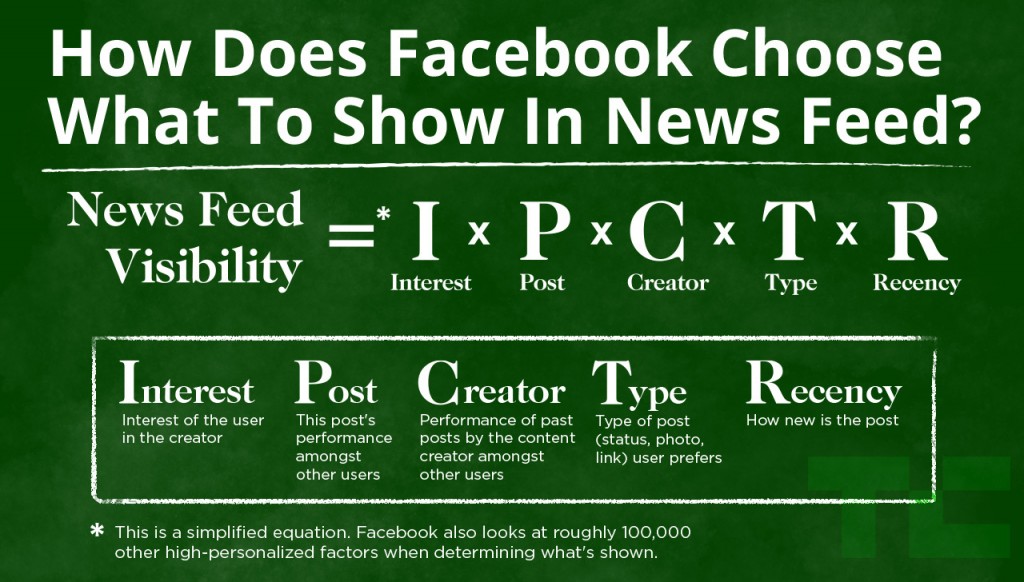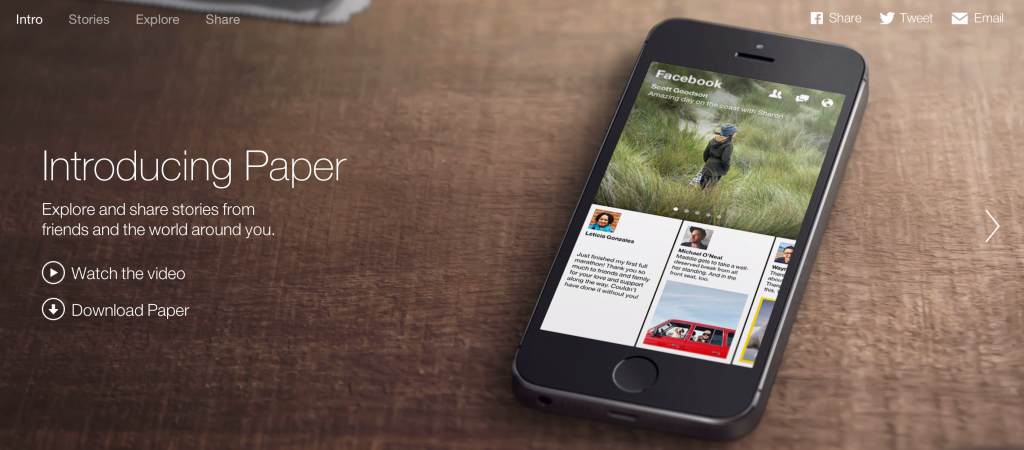 Unless you’ve been ignoring everyone for the last 6 months or so, you’ve probably heard a few people complain about the decrease in organic reach for business pages on Facebook. There have been several updates and changes to Facebook, and the way it determines what shows up in a user’s newsfeed, that have (or should have) changed the way businesses and marketers are leveraging the social network. Before we get into all of that, let’s review why Facebook IS a big deal.
Unless you’ve been ignoring everyone for the last 6 months or so, you’ve probably heard a few people complain about the decrease in organic reach for business pages on Facebook. There have been several updates and changes to Facebook, and the way it determines what shows up in a user’s newsfeed, that have (or should have) changed the way businesses and marketers are leveraging the social network. Before we get into all of that, let’s review why Facebook IS a big deal.
According to recent Facebook stats (click to Tweet):
- There are over 1,310,000,000 monthly active users on Facebook
- Which is a 22% from 2012-2013
- There are currently over 54,200,000 business pages on Facebook
- People spend more than a combined 640 million minutes on Facebook each month
- There are over 7 million apps and websites that integrate with Facebook
- Over 22 million apps are installed on Facebook each day
- There are over 3 million links shared every hour on Facebook
Let’s Talk About Facebook’s News Feed
“The goal of News Feed is to deliver the right content to the right people at the right time so they don’t miss the stories that are important to them.”
That little quote is straight from Facebook’s ‘News Feed FYI‘ that was published in early August of 2013. While that may seem like a long time for most of us who are used to the fast pace of the social media world, everything that Facebook has done with their News Feed since that post supports the statement. As you dig through you’ll see that at any point in time there are over 1500 stories from friends, pages, and people they follow waiting to show up in the average user’s newsfeed. Unlike Twitter, the stories in the News Feed tend to stick for longer — which one of the key things that differentiates the two social channels — so there’s no reasonable way for the average user to see every post they’re connected to. That’s exactly why Facebook developed the News Feed Algorithm and initially it focused on pretty obvious variables like:
- How often you interact with the friend, Page, or public figure (like an actor or journalist) who posted the story.
- The number of likes, shares and comments a post receives from the world at large and from your friends in particular.
- How much you have interacted with this type of post in the past – the post format (photo, link, text) and the content — i.e. fans of kittens will see more kittens
- Whether or not the post has been or is being hidden by other users.
Even with these variables in place business pages were able to maintain a decent and steady organic reach by posting good content and actually engaging their fans. Fast forward to December of 2013 and Facebook’s announcement admitting the decline of organic reach for businesses:
“We expect organic distribution of an individual page’s posts to gradually decline over time as we continually work to make sure people have a meaningful experience on the site.”
This sent the digital marketing world into sheer panic. While many marketers speculated and published their opinions to the world, well-known companies like Social@Ogilvy conducted their own studies to confirm the end of organic reach on Facebook. In the chaos and panic of it all businesses and marketers began to assume that this is how it was going to be from now on, without considering the fact that Facebook would continue to alter their News Feed algorithm on a regular basis.
In April of 2014 TechCrunch shed some much-needed light onto the situation. Pointing out that there was a very real issue that Facebook was trying to solve for the user and the complexity of the algorithm itself. After a chat with the Facebook News Feed Director of Project Management they were able to identify a few of the most determinates of whether or not a post would show up in the News Feed:
- How popular (Liked, commented on, shared, clicked) are the post creator’s past posts with everyone
- How popular is this post with everyone who has already seen it
- How popular have the post creator’s past posts been with the viewer
- Does the type of post (status update, photo, video, link) match what types have been popular with the viewer in the past
- How recently was the post published
Digitas VP-Social Marketing Alex Jacobs made a great point when he said, “If brands were to continue reaching the same amount of people as a percentage of their fan base, [Facebook would] be giving preferential treatment to them over a user,” he said. “It’s just the fact of the matter in terms of platform growth and the amount of content that’s getting posted.”
 While this makes sense from a UX perspective, businesses continued their rage and rebellion, which is totally understandable considering that many of them had already spent hundreds or thousands (or more) of dollars building an audience on Facebook now had to pay even more to reach them. Some brands were so upset by the situation that the publicly ‘broke up’ with the social network.
While this makes sense from a UX perspective, businesses continued their rage and rebellion, which is totally understandable considering that many of them had already spent hundreds or thousands (or more) of dollars building an audience on Facebook now had to pay even more to reach them. Some brands were so upset by the situation that the publicly ‘broke up’ with the social network.
Facebook responded with the release of their ‘Generating Business Results On Facebook’ document which basically tried to reposition the situation as an opportunity for brands to more effectively target the right audience with their marketing budgets. The argument being that fans who have already engaged your brand by ‘liking’ your page and engaging with your posts are more likely to engage with your ads which should lead to a higher CTR and a lower CPA. Assuming that you have built a valuable and interested audience on Facebook. In our experience, they weren’t wrong but, that still doesn’t address the issue of brand’s having to pay for most of their fans to see anything they post.
In another effort to improve the user experience within the newsfeed, Facebook announced more changes at the end of April 2014 based on Mark Zuckerberg’s own experience. In short, Mark saw a post about his co-workers birthday over the birth of his niece. As a direct result, posts with ‘congratulations’ in the comments automatically receive a boost in organic reach. While they may seem trivial, we now know that the News Feed Algorithm actually incorporates the content of the comments instead of just the volume or frequency of the social actions. Zuckerberg also said, ““We’re testing a lot of things every day to figure out what’s going to make the most engaging feed,”which basically means that we’ll never really understand exactly how it works without getting a spy inside the walls of Facebook HQ.
I won’t start my own rant at this point about why you should just accept the situation but I WILL point you towards a solid argument from Insidefacebook.com that basically points out the fact that Facebook is a business and that they should be prioritizing the user over the business because if they didn’t the entire network would fail and everyone would lose.
Let’s Talk Facebook Strategy
Verified Pages
In May of 2013 Facebook announced that they would be rolling out verified pages to (mostly) celebrities and big brands. Most of us just brushed it off as another pointless feature (like hashtags) and an attempt to integrate the better parts of Twitter. fast-forward to now and we’re seeing verified pages reaching 60%-80% of their audience organically, and that’s without receiving high amounts of engagement! Unfortunately, Facebook has yet to roll out a process for businesses to apply/qualify for verified accounts, so all we can do at this point is watch and wait.
Preferred Publishers
Facebook has announced on several occasions that they want to become a better source for ‘real-time news’. One of the things they’ve done to support this goal is to actually give some publishers free advertising within the network. They also recently rolled out their FB Newswire to help build their relationship with the journalism community and their ‘Paper’ app to focus on building their relationship as a content source with the user.
We now know that Facebook is actually defining the quality of the content based on the source itself. Our team can verify that posts from certain publisher perform better than others prior to any form of engagement. As far as we can tell, Facebook has drawn the line between publishers who publish both online and in print and publishers who only publish online.
For example: Posts from Adweek have performed better than posts from Mashable or TechCrunch, even when they were covering the same, or very similar, stories.
If You’re Looking For More Data
Jon Loomer has been running a very interesting set of tests on the News Feed Algorithm and they are definitely worth considering. In general, I love Loomer as a source for advice and strategy within the Facebook Ads platform but I had a few concerns with his tests that everyone should consider before altering their strategy to incorporate his results. The biggest concern is that the algorithm is based on personal data and, as a marketer, Loomer is more likely to have ‘liked’ more business pages than the average user which would alter the results. So, while his numbers might be able to point you in the right direction, don’t forget that your target audience and customers might (are likely to) have a completely different experience within the feed.
Our Observations
The Single grain Social Team has been running our own tests over the last year and have come to a few reasonable conclusions that have held up within various industries, content categories, and audiences. Take a look at the list below to get a few ideas of what you can test within your own social strategy and then be sure to test regularly to see if what you’re doing is actually working.
- Likes, comments, and shares aren’t the only social actions that matter – On several occasions, we’ve seen posts with none of the three main engagement actions out perform posts with high amounts of engagement. After doing some digging, we came to the conclusion that there is a direct correlation between the number of clicks on a post and the organic reach, which makes sense in the context of Facebook’s goal to prioritize real-time news.
- As mentioned, the content source matters – If you’re curating content to publish you should definitely take the time to test and research different sources (that are relevant to your audience) to see if any automatically perform better than the others.
- Timeliness matters – If the story you post ends up being ‘big news’, Facebook may increase the reach of your post based on whether or not your fans have already seen it. If you can be the first one to post it you can ‘catch the wave’ and gain exposure for free.
- Trending Topics – Facebook recently rolled out ‘Trending Topics’ which show up on the right hand bar of the News Feed. We’ve found that posting about these topics does increase organic reach, but timeliness does factor in. You won’t see much of a boost if it’s already been trending for hours.
- Facebook Hates Like-Bait – Using creative images to catch people’s attention used to be a solid tactic to use within your overall channel strategy. You could have some posts focused on engaging the fans and some posts that would require them to click through to other content or offers. We’ve noticed that even if the image posts do get a decent amount of engagement, the actual reach is lower than most of the other posts on the page. This doesn’t mean you shouldn’t post images but it does mean that you should put more time into developing the images you do post.
There you have it, a history of one of the most paid-attention-to places within the entirety of the internet and an update on what works and what doesn’t. At this point you may be debating whether or not Facebook even makes sense for your business and the answer, in short, is maybe. Social media has been considered ‘owned media’ since it really tool off almost a decade ago. It was probably naive of us to think that these businesses were going to just let us have it forever but it’s important that we all move on and refocus. Here are some questions to help you decide whether or not you should make Facebook part of your marketing strategy:
- Do you already have an audience that’s worth leveraging? Earned organically through interest or through accurate targeting.
- Do you have an ad budget to work with? The Facebook ads platform is a force to be reckoned with.
- Are your customers using Facebook and can your brand be relevant within the context of Facebook? Most people get on Facebook to forget about work and to focus on their personal relationships and interests. if your brand can only relevant within the context of ‘work’ you might want to look elsewhere.
- Do you have a plan to leverage Facebook for business results? You need to have a funnel in place that will work on turning your Facebook fans into customers, otherwise you’re wasting your time.
Want to get personalized, specific ideas on how you can leverage Facebook’s algorithm to run high converting Facebook ads for your business? Click the green button below, and let’s chat!






